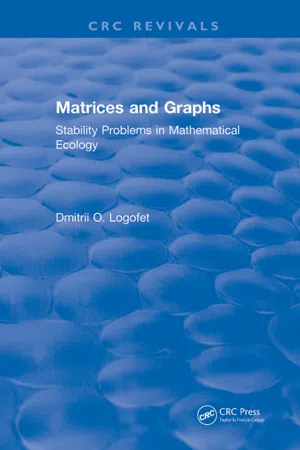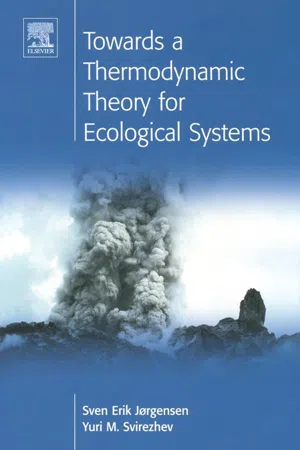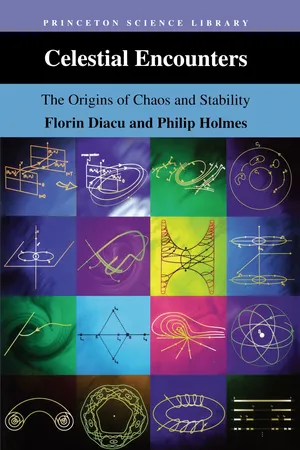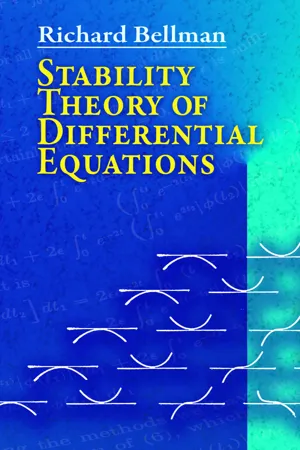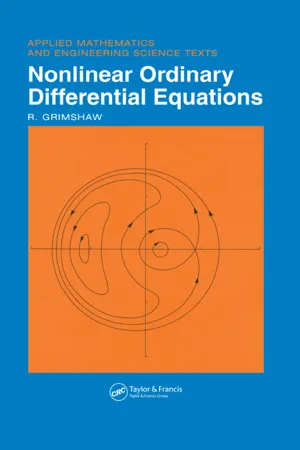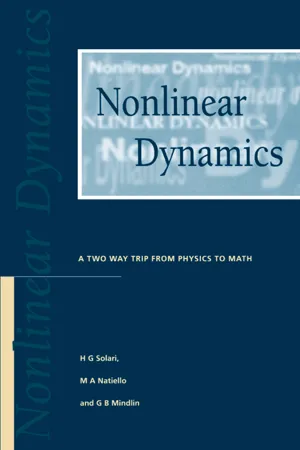Mathematics
Stability
In mathematics, stability refers to the property of a system or solution that remains unchanged or converges to a steady state over time, despite perturbations or disturbances. A stable system or solution is resistant to small changes and maintains its equilibrium. Stability is a fundamental concept in various mathematical fields, including differential equations, control theory, and dynamical systems.
Written by Perlego with AI-assistance
Related key terms
10 Key excerpts on "Stability"
- D. Logofet(Author)
- 2018(Publication Date)
- CRC Press(Publisher)
1Stability Concepts In Ecology and Mathematics
Understood generally as an ability of a living system to persist in spite of perturbations, Stability can be defined in many ways, both in verbally descriptive and formal terms, either in ecology or mathematics. While neither one of these “ecological” meanings of Stability can now be recognized as being more fundamental than the other, mathematics has the greater advantage, since it has given rise to the notion of Lyapunov Stability, which appears to be inherent in or important to any further conceptions of Stability—at least, within the theory of dynamical systems. To see whether and how this mathematical substantiality has produced any consequences in ecology, we concentrate, in this introductory chapter, on the way this notion is applied in mathematical theory of population, community, or ecosystem dynamics, or more shortly, in the proper chapters of mathematical ecology.I. Basic Approaches to the Notion of Stability
In spite of appearing to be intuitively clear, “an ability to persist in spite of perturbations” can scarcely be defined in a unique and unambiguous way. The reason for this difficulty is that both the “persistence” and the “perturbations” parts of the idea need further clarification, to say nothing of the scale factors of the system being considered. What is understood by “an ability to persist” and what kind of “perturbations” is relevant? Different answers to these basic questions and a variety of Stability concepts have been proposed and discussed in the ecological literature,1 and 2(yet only a few of them have been given proper mathematical attention3 and 4). Perhaps this is why Stability in general lacks—and should apparently not have—any “stable” definition.A. Species Diversity as a Measure of Stability
- S.E. Jorgensen, Y.M. Svirezhev(Authors)
- 2004(Publication Date)
- Pergamon(Publisher)
Though the notion of Stability seems obvious, it is quite a problem to provide it with a precise and unambiguous definition. In fact, Stability can be defined in quite a lot of ways, both in verbal and formal terms, either in ecology or mathematics. While none of the “ecological” meanings of Stability can now be recognised as the most fundamental one, mathematics is “luckier”, giving rise to the notion of Lyapunov Stability. It appears to be inherent in, or substantial for, any further notion of Stability—at least within the theory of dynamical systems. And even then, this heavily overloaded term found no established (“stable”) definition. For instance, the theory of Stability, which can be considered as a branch of applied mathematics and mechanics, uses about 30 different definitions of Stability. So, the definition of Stability is some “fuzzy” definition. Paraphrasing von Neumann’s sentence, we can say that “… nobody knows what Stability means in reality, that is why in the debate you will always have an advantage”.6.2 Stability concept in thermodynamics and thermodynamic measures of Stability
Among the different definitions, we can select two large classes differing with respect to the requirements coming under the heading of “Stability”. The first group of requirements concerns preservation of the number of species in a community. A community is stable if the number of member-species remains constant over a sufficiently long time. This definition is the closest to various mathematical definitions of Stability, such as those of Lagrange and Poincaré–Lyapunov.The second group refers rather to populations than to community, which is considered to be stable when numbers of component populations do not undergo sharp fluctuations. This definition is closer to the thermodynamic (or rather, statistical physics) notion of system Stability. In thermodynamics (statistical physics) a system is believed to be stable when large fluctuations, which can leave the system far from equilibrium or even destroy it, are unlikely to happen (see, for instance, Landau and Lifshitz, 1995 ). Evidently, general thermodynamic concepts (for instance, the Stability principle associated in the case of closed systems with the Second Law and, in the case of open systems, with Prigogine’s theorem) should be applicable to biological (and, in particular, ecological) systems.There is a very deep connection between thermodynamics as a physical theory and the mathematical theory of Stability. One of the most important concepts in the theory of Stability is the Lyapunov functions concept. Positive functions, defined in a phase space of a dynamical system, possess the following property: either monotonous increase or monotonous decrease along trajectories. They can be considered as some special class of goal functions. On the other hand, the main thermodynamic laws (the Second Law, Prigogine’s theorem) state the similar properties of monotonicity for special functions called potentials, entropy, etc. These functions are Lyapunov functions and thermodynamic laws can be considered as applications of the direct Lyapunov method to special dynamical systems.- eBook - ePub
Analytical Network and System Administration
Managing Human-Computer Networks
- Mark Burgess(Author)
- 2012(Publication Date)
- Wiley(Publisher)
Chapter 10
Stability
One of our fundamental premises about systems is that medium-term Stability, allowing for long-term change, is a desirable concept. Systems must be predictable for long enough to perform their intended function. This applies both to the human and machine parts of a system. However, we still need a quantitative description of what such Stability means, and on what timescales.10.1 Basic notions
If we place a ball at the crest of a hill, the slightest movement will cause it to roll down to the bottom. A ball placed at the top of a hill is a mechanical system that is said to be unstable to small perturbations, that is, a small push changes the character of the system. By contrast, a ball placed at the bottom of a valley or trough is said to be stable to perturbations, because a small push will only take it a short way up the hill before it rolls back down again, preserving the original condition of the system.Stability is an important idea in systems. If a small change can completely alter a system, then its usefulness is limited. A bomb is a chemical–mechanical system that can be used only once, because it is impractical to reset it to its original condition once it has exploded. InStability affects a great many dynamical systems, from financial systems, to computers, to social systems. The idea of building Stability into systems is thus of central importance to human–computer administration.Modern fighter jets are built with an inherent inStability under flight, unlike passenger jets that are inherently more stable. Fighter jets are much more manoeuvrable because of this ability to lapse into inStability. The price one pays for this is a much more essential and risky regulation requirement that maintains the system right at the edge of inStability, allowing rapid, controlled change, but flirting with rapid, uncontrolled change. - Liansheng Tan(Author)
- 2017(Publication Date)
- Butterworth-Heinemann(Publisher)
5Stability
Abstract
This chapter gives an introduction to the most important and basic elements in the Stability theory. We survey the following theoretical concepts, terms, and statements: internal Stability, Lyapunov Stability, and input-output Stability.Keywords
Internal Stability; Lyapunov Stability; Input-output StabilityThere have been a large number of references on Stability theory for ordinary differential equations, to mention a few [70 , 76 –86 ]. On the basis of the above references, this chapter serves a tutorial summary on Stability of linear system, which covers the topics of internal Stability, Lyapunov Stability, and input-output Stability.5.1 Internal Stability
Internal Stability deals with boundedness properties and asymptotic behavior (ast → ∞) of solutions of the zero-input linear state equation= A ( t ) x ( t ) , x (x ( t ).t 0) =x 0.(5.1)While bounds on solutions might be of interest for fixed t 0 and x 0 , or for various initial states at a fixed t 0 , we focus on boundedness properties that hole regardless of the choice of t 0 or x 0 . In a similar fashion the concept we adopt relative to asymptotically zero solutions is independent of the choice of initial time. The reason is that these “uniform in t 0 ” concepts are most appropriate in relation to input-output Stability properties of linear state equations.It is natural to begin by characterizing Stability of linear state equation (5.1 ) in terms of bounds on the transition matrix Φ(t , π ) for A (t ). This leads to a well-known eigenvalue condition when A (t ) is constant, but does not provide a generally useful Stability test for time-varying examples because of the difficulty of computing Φ(t , π ).The first Stability notion involves boundedness of solutions of Eq. (5.1- eBook - ePub
Celestial Encounters
The Origins of Chaos and Stability
- Florin Diacu, Philip J. Holmes(Authors)
- 2020(Publication Date)
- Princeton University Press(Publisher)
Structurally stable flows confer a certain robustness on the mathematical models in which they occur. Measurements are never absolutely exact; one must always take a margin of error into account. If a bifurcation occurs at the value we have measured, we cannot say to which type of behavior the physical situation corresponds. If the flow is structurally stable, then we are able to guarantee qualitative accuracy around the measured data.Catastrophe theory, a fairly young branch of mathematics that stimulated a number of controversies and some journalistic turbulence during its early years, has adapted the notion of structural Stability to its own purposes. In this case also, one is concerned with how the qualitative properties of functions depend upon external parameters.Structural Stability and bifurcation remain central issues in the theory of dynamical systems, with important implications outside of mathematics. They have already found applications in the study of the heart, in embryology, linguistics, optics, psychology, hydrodynamics, economics, elementary particle physics, geology, and numerous other areas.PLANETS IN BALANCE
An important notion related to Stability questions in celestial mechanics is that of a central configuration. In 1767 the sixty-year-old Leonhard Euler published a study of the three-body problem. In it he explicitly obtained a whole class of periodic solutions. He proved that if three particles of arbitrary (finite) masses are arranged initially on a line, as in figure 4.11 , such that the ratio ABIBC has a certain value given by a complicated formula depending on the masses, and if suitable initial velocities are assigned to the particles, then they will move periodically on ellipses, maintaining at all times a collinear configuration. Moreover, the ratio ABIBC of distances measured along the rotating line AC will remain unchanged throughout the motion. This is quite striking since, as we have pointed out, the addition of a third body to the two-body problem generally perturbs the elliptical Keplerian orbits and may even cause chaos.In 1772 Lagrange rediscovered the Eulerian solutions of the three-body problem and found a second important class of orbits. He showed that if, at the initial moment, the three particles lie at the vertices of an equilateral triangle (a triangle with equal sides) and if, again, suitable initial velocities are taken, then the masses will move periodically on ellipses, as in figure 4.12 , preserving always their equilateral configuration. The triangle will change its size and orientation as the particles orbit, but throughout it remains equilateral. Not surprisingly, these are called Lagrangean solutions. - Wolfgang Hahn(Author)
- 2019(Publication Date)
- Dover Publications(Publisher)
The function v entering the Stability Definition 34.1 is chosen as a quadratic form of all variables. As usual, a condition for absolute Stability (Definition 14.1) is obtained by discussing the sign of its total derivative for the equations of motion: A certain quadratic form of the quantities p j (t) and some auxiliary parameters, must be negative definite. However, the practical evaluation of this condition is rather difficult. Štelik [1] and Czan [1, 3] established a relation between the concept of Stability in a finite interval and the determination of optimal control (Sec. 6, Remark 6; cf. also Lebedev [4], S. K. Persidskii [2], Kudakova [1]). 35. DIFFERENTIAL EQUATIONS WITH BOUNDED SOLUTIONS Applying the considerations of Sec. 3 to the case where the function v is positive in the exterior of a certain sphere and where v is negative in that domain, it can be concluded that the phase trajectories penetrate those hyper-surfaces v = const which are sufficiently far away from the origin from the outside to the inside. Consequently, all solutions with bounded initial points are bounded themselves. If t is greater than a sufficiently large t -value, the absolute values of these solutions are even smaller than a fixed upper bound. Criteria for boundedness can be derived for special differential equations, cf. e.g., Reuter [1, 2]. Yoshizawa developed this method systematically in several publications ([2 to 8], in particular [9]). Apparently, his investigations are originally independent of the considerations of Liapunov. The analogy to the direct method is obvious and is emphasized by the fact that the boundedness of the solutions can be interpreted in the sense of a Stability property of the trivial solution. LaSalle [2] introduced the terminology: “Stability in the sense of Lagrange.” To the different types of Stability (cf. Secs. 4 and 17) there correspond different types of boundedness- eBook - ePub
- Richard Bellman(Author)
- 2013(Publication Date)
- Dover Publications(Publisher)
t → ∞. This condition yields many interesting results. However, occasionally we shall require the stronger conditions(5)or(5′)Essentially we see that the problem is that of imposing a suitable metric upon the space of variable matrices. Once this viewpoint has been taken, it becomes clear that the same procedure is advantageous in discussing the behavior of the solutions of (1) as t → ∞. We shall investigate, variously,(6)or(6′)or, if these are infinite,(6″)or, occasionally,(6′″)Each of these functionals has an important role to play in the study of the properties of the solutions of (1) for large values of t .The point of the preceding discussion is that, in comparing the solutions of (1) with solutions of (4), we must agree to fasten our attention upon the class of perturbing matrices B (t ) we are admitting and upon the property of the solution in which we are interested. We may expect that some properties will be preserved under one class of perturbations and not under another, and this is indeed the case.These preliminary remarks lead to a rigorous concept of Stability for linear equations:Definition. The solutions of(7)are stable with respect to a property P and perturbations B (t ) of type T if the solutions of(8)also possess property P. If this is not true, the solutions of (7) are said to be unstable with respect to property P under perturbations of type T.To illustrate this concept, consider the two simple differential equations(9)where a > 0 and where b (t ) → 0 as t → ∞. Both solutions have the properties(10)If, however, a = 0 and b (t ) = 1/t , (10b ) is preserved, but (10a ) is not, since v is unbounded although u is bounded. Consequently, there is Stability with respect to the property of (10b ), but inStability with respect to the property of boundedness. If we replace 1/t by a function which is integrable over (t 0 , ∞), then boundedness will be preserved.Perhaps the most important property of the solutions is that of boundedness. If a solution is bounded, we are interested in knowing whether or not it approaches zero as t → ∞ and, in general, in examining the possible set of values it assumes as t → ∞. If the solution is unbounded, we may wish to examine the ratio (log y )/t - eBook - ePub
- R. Grimshaw(Author)
- 2017(Publication Date)
- Routledge(Publisher)
CHAPTER FOUR Stability 4.1 Preliminary definitions Consider the first-order systemx ′= f(,x , t)(1.1) where, to avoid unnecessary complications, we shall suppose that f(x, t) is defined and continuous for all x and all t ⩾ t0 , and satisfies a Lipschitz condition in x in any bounded domain. Then, for the initial-value problem
the uniqueness and existence theorems of section 1.3 (theorems 1.3 and 1.4) show that there is a unique solutionx(=t 0)x 0,(1.2) x = x(t ;)x 0,t 0(,)t 0⩽ t < Twhere, by theorem 1.7 (section 1.4), either |x| → ∞ as t → T or T = ∞. We shall suppose here that the latter alternative holds, and so x(t;x0 ,t0 ) is defined for all t ⩾ t0 . This will not be a significant restriction as in the applications to follow x(t) will either be a constant or a periodic function of t.Stability is concerned with the question as to whether solutions which are in some sense close to x(t) at some instant will remain close for all subsequent times. Clearly, Stability is a desirable property as dynamical processes, modelled here by the system of equations (1.1 ), are often subject to small, unpredictable disturbances. Unstable solutions are thus extremely difficult to realize either experimentally or numerically, as an arbitrarily small disturbance will eventually cause large deviation from the unstable solution. It is important to distinguish here between Stability and the Hadamard notion that the initial-value problem be well-set. We have already shown in theorem 1.2 (section 1.3) and theorem 1.5 (section 1.4) that the initial-value problem for (4.1 ) is well-set in that the solutions, inter alia, are continuous functions of the initial value x0 . Thus solutions which are close to x(t) at t = t0 , will remain close for some interval t0 ⩽ t ⩽ t0 + δ. The important point here is that, in general, these results hold only for some finite interval of time t (i.e. δ is finite), whereas Stability is concerned with the behaviour of neighbouring solutions to x(t) for all times t ⩾ t0 - eBook - ePub
Nonlinear Dynamics
A Two-Way Trip from Physics to Math
- H.G Solari(Author)
- 2019(Publication Date)
- CRC Press(Publisher)
n) may be arbitrarily apart far away from the fixed point(s). For the harmonic oscillator, the difference of the vector fields in the cases with/without dissipation is just the dissipation:which is unbounded unless we restrict our considerations to a small compact submanifold in phase space where for example the supreme norm would do the job. 5.6 Summary|=f|(− f ′x , p)(x , p)|v p|Stability theory is the natural continuation of the set-theoretical analysis started in chapter 4 . It provides tools to both identify some invariant sets and to assess the behaviour of the flow (or map) around these sets.Now we can improve our predictive tools by saying not only how certain invariant sets look, but also under what conditions the system will end up in one of these sets.Structural Stability will be a useful tool when we try to answer questions such as the one raised in chapter 3 : can the Stability of a fixed point change when we alter the parameters in the system? (Remember Lorenz in chapter 3 .) Is there a systematic way of understanding the possible changes?5.7 Additional exerciseExercise 5.8: Let us consider the Stability of the solutions of the autonomous system described in exercise 4.19. Show that this 2-d system has a fixed point at the origin and two limit cycles: an unstable one at r = r†cand a stable one at r = 1. Notice that the frequency of the inner limit cycle is larger than the frequency of the outer one. - eBook - ePub
Robot Hands And Multi-fingered Haptic Interfaces: Fundamentals And Applications
Fundamentals and Applications
- Haruhisa Kawasaki(Author)
- 2015(Publication Date)
- WSPC(Publisher)
ε < 0.Example 5.2. Consider the system:This is well known as the Van der Pol equation. The solution from arbitrary initial value except for the origin converges to a limit cycle as shown in Fig. 5.5. The system is unstable, because an initial condition such that < ε for an arbitrary ε > 0 does not exist.From the perspective of many engineering applications, knowing that a system converges to the origin after an infinite time period is not sufficient. What is needed is an estimate of how fast the state of the dynamic system converges to the origin. The concept of exponential Stability will be used for this purpose.Definition 5.3. (Exponential Stability)The equilibrium point of Eq. (5.4) is said to be exponentially stable if it is asymptotically stable and if there exist three positive numbers a, b, r such that if < r, then ≤ a e−bt for all t ≥ 0.%Fig. 5.5. Unstable origin of van der Pol equation.Exponential Stability means that solutions not only converge, but converge to the origin faster than the exponential function a e−bt . The positive number b is often called the rate of exponential convergence. The stabilities mentioned above are defined on a neighborhood around an equilibrium point. In some applications, global properties are important. There are two definitions of Stability for the arbitrary initial state on n .Definition 5.4. (Global asymptotic Stability)The equilibrium point of Eq. (5.4) is said to be globally asymptotically stable if it is asymptotically stable for arbitrary initial states.Definition 5.5. (Global exponential Stability)The equilibrium point of Eq. (5.4) is said to be globally exponentially stable if it is exponentially stable for arbitrary initial states.Example 5.3. Consider the systemA solution of the system is given by Then, we getEquation (3) holds for arbitrary initial state x
Index pages curate the most relevant extracts from our library of academic textbooks. They’ve been created using an in-house natural language model (NLM), each adding context and meaning to key research topics.
